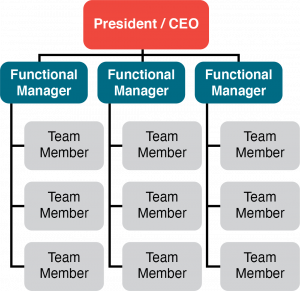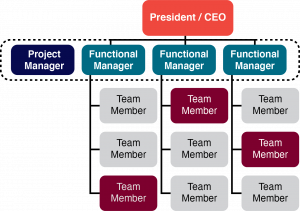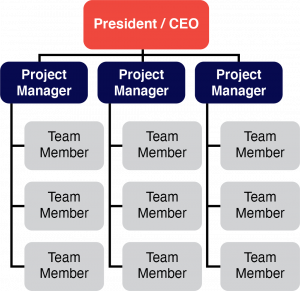Chapter 2 – Culture and Structures of Organizations
2.2. Structures
There are three broad structures by which an organization can be organized: functional, matrix, and projectized. These structures represent a continuum, from structures where the project manager has very little authority (functional) to those where project managers have very broad power (projectized) (See Figure 2-1).
There have been many studies about the impact that organizational structure has on project success, and it is not uncommon for corporations to change their organizational structure in order to increase their relative success in executing projects on time, and within budget. This type of change takes great effort and may take a long period of time to fully implement. Instead of changing their entire structure, an organization may elect to create a dedicated project team in order to carry out a critical project without reorganizing the entire enterprise. This way, they can get many of the same benefits of the projectized organization without reorganizing the enterprise. This approach is not without risk, as we’ll explore in the section on dedicated project teams.

Functional Organizations
Perhaps the least project-focused type of organization are functional organizations. Large organizations are traditionally organized by function into various departments, with staff in each department reporting to a departmental manager or head of department. This allows for groupings of specialists within the organization where they can work together, share knowledge and prioritize their work. Traditional functional departments might include:
- Human resources
- Accounting
- Procurement
- Marketing
- Sales
- Shipping
These functional units work independently of each other, and the functional managers (regular managers) serve as conduits for communications and collaboration (See Figure 2-2). This type of structure is very efficient for operations management where continuous process improvement can be conducted on all regular departmental operations. However, it is not optimal for the completion of projects. Human resources departments often work within functional organizations.

HR in Focus
Primarily, there are six functions within human resources and they include: recruitment and selection, health and safety, employee-employer or industrial relations, compensation/benefits, labour law compliance, and training and development. The HR function strengthens the employer-employee relationship. Within a functional organization, the HR department provides the structure and aptitude to meet business needs through the company’s most valuable asset-the employees.
Projects often require work across disciplines. There are several HR disciplines, however HR specialists in each discipline may fulfill one or more of the six functions. In the functional organization, with staff isolated inside their departmental “silos,” communication is directed through the functional managers. These managers often have differing priorities, which can make communications slow and error-prone in a functional organization. However, human resources, as a department, may act as a conduit to the other departments and help them work collaboratively as departments, or with projects.
The success of projects within a functional organization depends on functional managers working together and co-operating. While someone may be designated as the project manager for a particular project, that person may not have much authority (See Figure 2-3). Often titles such as Project Coordinator, Project Scheduler, or Project Expediter will be used instead. Regardless of title, those in charge of projects are often put in the role of simply trying to maintain a schedule of what is happening.

The PMI identifies the following project characteristics for projects conducted in functional organizations:
- Project Manager’s Authority: Little or None
- Resource Availability: Little or None
- Who Manages the Project Budget: Functional Manager
- Project Manager’s Role: Part-time
- Project Management Administrative Staff: Part-time
Projectized Organizations
Projectized organizations are at the opposite end of the organizational spectrum from functional organizations. Organizational energy and resources are focused on completing projects rather than ongoing operations. In a projectized organization, operations are minimal and the project manager has great authority over resources and personnel decisions. Projectized organizations may have organizational units called departments and these groups either report directly to the project manager or provide support services to projects. In the project-based structure, personnel are specifically assigned to the project and report directly to the project manager (See Figure 2-4). The project manager is responsible for the performance appraisal and career progression of all project team members while on the project.

HR in Focus : HR & Projectized Organizations
An HR Project Manager in a projectized organization would work with any or all departments on projects. They could manage the project if it was part of an HR function, or they may support the project in relation to “people.” In this case, the Project Manager would determine the people who would be needed for the project, participate in the hiring or assigning of team members, support coordination related to communication between and among the stakeholders, create job descriptions for the team members, ensure all the roles and responsibilities for the team are assigned, understand and provide all the training for the team as it relates to the project, provide reports on performance of team members individually and as a group, or create recognition and reward systems for the project team.
Employees in a dedicated team in this type of environment are able to focus their loyalty to a project rather than their particular discipline. Not all people can succeed in such an organization, as they must adapt to the leadership styles and organizational skills of different project managers. Human resources specialists can support this adaptation by training team members in various leadership styles and how to modify their behaviour to match different project manager leadership styles.
Examples of project-based organizations include construction companies, aeronautical manufacturers, training and development companies, personnel and hiring companies, and many software development companies. This type of organizational structure can put additional stress on employees if they have no home to return to once their project is over, or if they are not selected for a subsequent project. Human resources can play an active role in supporting employees to find other work within the organization, or to provide external job search support.
Projectized organizations are considered ideal for project management since there is a significant reduction in the layers of bureaucracy that a project manager must navigate. PMI identifies the following project characteristics for projects conducted in projectized organizations:
- Project Manager’s Authority: High or Absolute
- Resource Availability: High or Absolute
- Who Manages the Project Budget: Project Manager
- Project Manager’s Role: Full-time
- Project Management Administrative Staff: Full-time
Matrix Organizations
While the functional structure may work well in times of little change, it has some serious limitations when the success of a company depends on being adaptable. A matrix structure tries to combine the strengths a functional organization provides for operations management with the strengths a projectized organization provides for project management. In a matrix organization, the functional and project manager share authority and responsibility. This can lead to several negatives:
- Employees can have two supervisors to which they have to report, breaking the rule of a solitary chain of command.
- Employees have to balance their work between the needs of the projects, they are working on, and their functional unit.
- Supervisors may find that it is more difficult to achieve a consistent rate of progress since employees are often pulled in different directions.
- Costs and communication channels can increase.
However, there are several advantages to a matrix structure in terms of projects:
- It significantly disrupts the communication “silos” of a functional organization, creating a more horizontal structure for teams and increasing the flow of information.
- It allows people to concentrate of their areas of specialty and bring that strength to current projects.
PMI recognizes three types of matrix structures, as described below (See also Figure 2-5).

Weak Matrix: The project manager has less authority over resources and people than the functional managers. Project managers in a weak matrix may go by other titles such as a project coordinator or project scheduler.
Balanced Matrix: In a balanced matrix, the project manager and functional managers equally share authority over resources and staff. This allows the organization to experience the “best of both worlds” by receiving the benefits of a projectized organization and functional organization at the same time. However, this system presents many challenges:
- Functional managers and project managers have to work well together and maintain regular communications. Staff will have two managers to which they have to report, breaking the concept of the chain of command and organization.
- If functional and project managers have conflicting priorities, subordinates may be unable to meet expectations.
Strong Matrix: In a strong matrix, the project manager has more direct control over resources and staffing, while the functional manager will provide support to the project staff in terms of hiring, technical expertise, and professional development. Of all the matrix structures, this is the one in which the project manager has the most authority, and the functional manager has the least.
HR in Focus: Human Resources and Matrix Organizations
Human Resources departments can assist projects and project managers in matrix organization similar to a functional organization or a projectized organization. Human resources specialists can reduce or eliminate the negatives of a matrix organization.
- They can support team members and supervisors in streamlining the reporting systems to avoid confusion and frustration for all concerned.
- They can provide assistance in helping the employees balance their work between projects and their functional role within the unit. Extra workers can be hired to temporarily replace project team members. Clear job descriptions can be created to reduce confusion of loyalty to the project and the functional unit, as well as helping to avoid burn-out of employees attempting to balance two different roles.
- These strategies also reduce the stress for supervisors and project managers; in turn improve the rate of progress for the projects.
- Human Resources departments can create clear and coordinated communication channels between all the stakeholders improving relationships, resolving problems, and building trust among the stakeholders.
Dedicated Project Team
Many functional organizations find that they often need to carry out important projects but do not want to change their entire organizational structure. Recognizing the advantages that are achieved by giving authority to a project manager, functional organizations often organize dedicated project teams where a project manager can have authority over the staff assigned to that particular project. The project manager and project team members are sometimes located in a special office, away from the desks and duties that they normally have within the functional organization (See Figure 2-6). This can be a very effective way to complete projects. However, some difficulties can arise:
- Temporary loss of staff from the functional groups.
- Integration of project team members back into the functional organization after the project is completed can be difficult.
- An “us versus them” mentality, where the people on the project team are deemed to be more special than those working in the functional departments. There have been numerous case studies of conflict arising from dedicated project teams.

HR in Focus: Human Resources and Dedicated Project Teams
Human Resources departments can help reduce or eliminate difficulties experienced by dedicated teams.
- They can help replace staff lost to the dedicated team within the functional unit.
- They can assist both the functional employees and the dedicated team to integrate back into the functional organization after the project is completed by facilitating meetings, discussing and resolving concerns of individual team members, establishing new work goals for team members, and provide training for supervisors on how to integrate employees back into their unit.
- They can provide facilitated meetings with all members of the unit to discuss any concerns and allow the unit members to come up with solutions to work in harmony to avoid “us versus them” mentality.
Think!
If you have worked in any job, you may be able to figure out what type of organization you work for by the different structures explained above. What type of organization was your past/current employer? When you are working as an Human Resources Specialist upon graduation, which structure of organization would you like to work for? Why?

